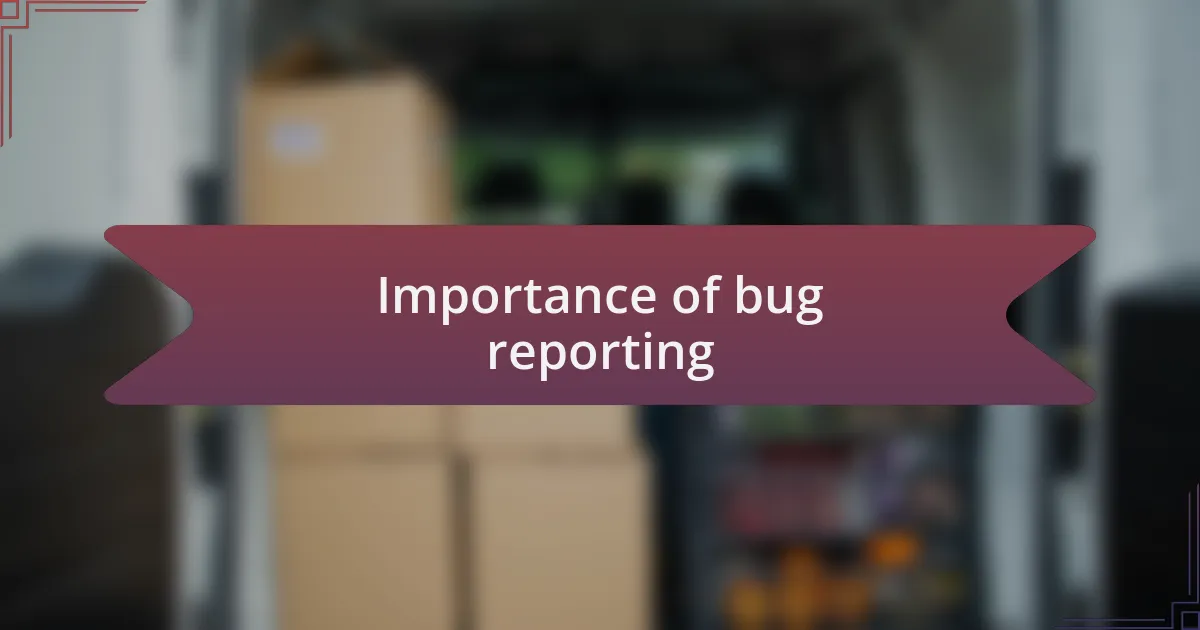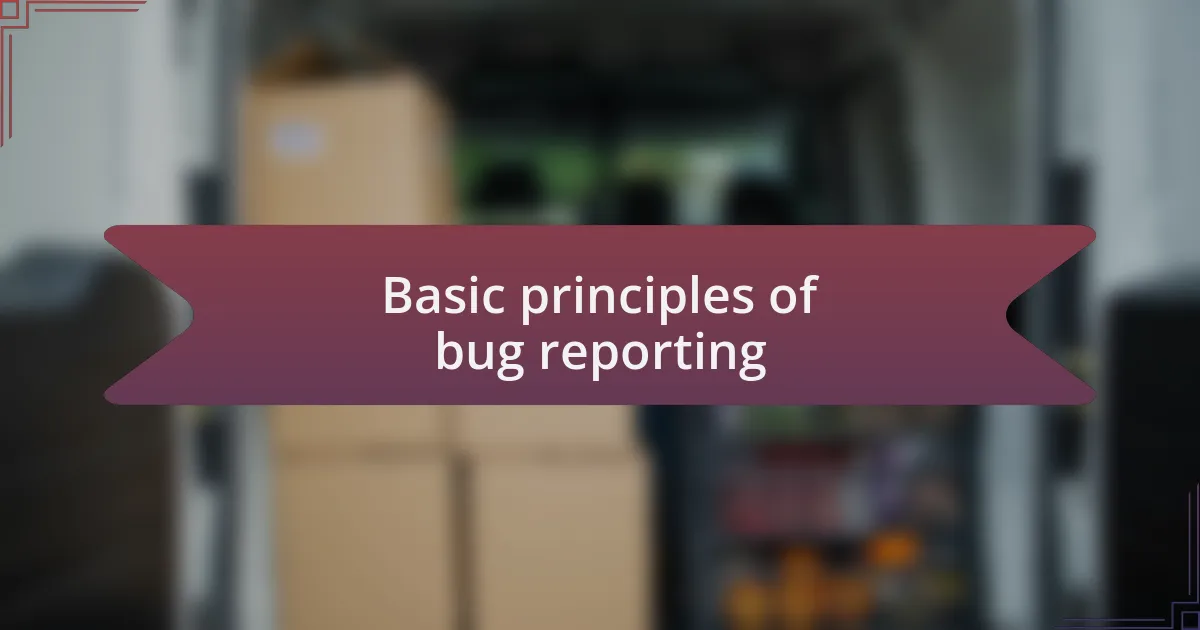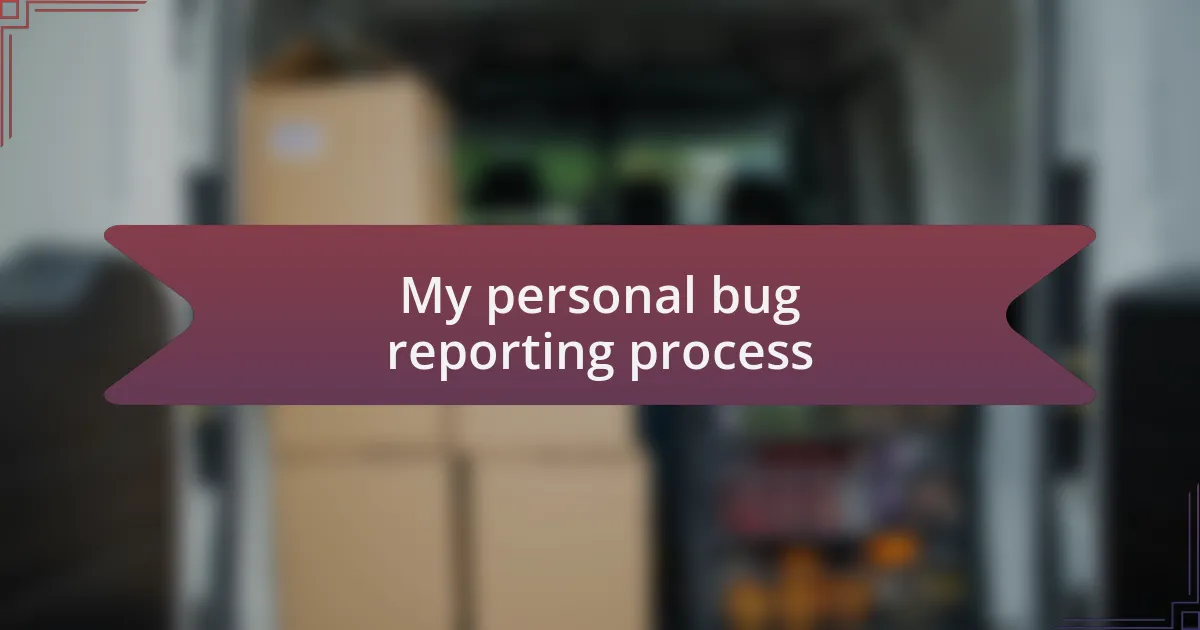Key takeaways:
- Clear and detailed bug reports save time, enhance collaboration, and improve the software development process.
- Timely reporting can prevent escalation of issues and positively impact project timelines and customer satisfaction.
- Including reproduction steps and visual aids, such as screenshots, can significantly accelerate bug resolution.
- Using a positive tone in bug reporting fosters a constructive dialogue and encourages team collaboration in problem-solving.

Understanding bug reporting
Understanding bug reporting is essential for streamlining the software development process. From my experience as a developer, I’ve seen how a well-documented bug report can save hours of debugging time. Have you ever received vague feedback about an issue? It can be frustrating and time-consuming to address problems without clear context.
I remember a project where I missed a critical bug because the report only mentioned “it doesn’t work” with no further details. This taught me the importance of clarity; I now encourage teams to include steps to reproduce, screenshots, and any error messages. Such comprehensive reports create a dialogue that fosters collaboration and leads to quicker resolutions.
Moreover, effective bug reporting fosters a culture of transparency and accountability. When I see a detailed report, I feel more equipped and motivated to dive into the problem. It’s not just about fixing bugs; it’s about understanding how they affect the user experience and learning from each issue. Wouldn’t you agree that this kind of insight not only enhances our products but also strengthens our teams?

Importance of bug reporting
Bug reporting is fundamentally important because it acts as the bridge between developers and testers. In my experience, when reports are thorough, they provide invaluable insights that guide development priorities. Have you ever faced a situation where a bug’s complexity overshadowed its impact? A detailed report can shed light on how a seemingly minor issue might disrupt user experience significantly.
I’ve had moments where a simple bug report transformed into a learning opportunity for the entire team. One time, a colleague reported a recurring issue with our login system, detailing not only the error but also the scenarios in which it occurred. Thanks to that clarity, we identified an underlying design flaw, preventing future problems before they escalated. Isn’t it fascinating how a single report can enhance our knowledge and help grow our skill sets?
Moreover, timely bug reporting can directly influence project timelines and customer satisfaction. I once participated in a project where delayed bug reports led to an avalanche of issues post-launch. It became evident how crucial it was to catch problems early—like catching a leak before it floods an entire room. How much smoother would your projects run if everyone shared an understanding of the importance of immediate and clear reporting?

Common types of software bugs
When discussing software bugs, some of the most common types include syntax errors, logical errors, and runtime errors. I’ve encountered syntax errors many times—those pesky typos or misplaced characters that cause the entire code to fail. It’s almost funny how a simple misplaced comma can derail a project until it’s identified and corrected. Have you ever spent hours debugging, only to find it was just a minor oversight?
Another prevalent category is logical errors, which can be particularly frustrating. I recall a project where the application was generating incorrect outputs due to a flawed equation in the code. Despite being error-free in syntax, the logic was completely off. It was a vital lesson in the importance of reviewing code not just for “how it looks,” but for “how it works.” This type of bug often leads to unexpected behavior that can confuse users—like ordering an item that never arrives!
Lastly, runtime errors deserve mention, as they arise during program execution and can strike like an unexpected thunderstorm. I once had a user report an application crash that occurred under certain conditions. After thorough investigation, we discovered that the app couldn’t handle specific data inputs. It was a moment of realization for me: bugs can exist quietly until a user interaction surfaces them. Isn’t it intriguing how different bug types can reveal unique insights into software reliability?

Basic principles of bug reporting
Effective bug reporting is essential for streamlining the development process. When I report a bug, I focus on providing a clear and concise summary that encapsulates the issue. It’s almost like creating a mini-story—what happened, what I expected to happen, and what actually occurred. This not only aids the developers but also prevents misunderstandings that can lead to wasted time.
Details are crucial in bug reporting, and I’ve learned this the hard way. Once, I submitted a bug report without including the specific browser version, thinking it was irrelevant. The developer spent hours trying to reproduce the issue, only to find it was unique to my version. Such experiences taught me that no detail is too small—every piece of information can save valuable time and frustration down the line.
Additionally, attaching relevant screenshots or logs can be a game-changer. I vividly recall a time when a simple screenshot highlighting an error message accelerated the resolution process tremendously. It was a relief to see how the visual evidence helped convey the issue precisely. Isn’t it fascinating how sometimes a picture truly is worth a thousand words, especially in the complex world of software development?

My personal bug reporting process
When I prepare to report a bug, I always take a moment to replicate the issue. This step is vital, as it allows me to gather firsthand insights into the problem. I remember one instance where I overlooked this and reported the bug without confirmation. The result? A lengthy back-and-forth discussion that could have easily been avoided if I had taken those few extra minutes.
The format I use for detailing the bug is straightforward but effective. I typically start by categorizing it—critical, major, or minor. Last year, I encountered a major bug that affected user authentication. By classifying it correctly from the start, the development team prioritized its fix, demonstrating how a little organization can enhance communication. Don’t you think clarity in urgency can really shift a development team’s focus?
I can’t stress enough how beneficial it is to embrace follow-up after submitting a bug report. After reporting an issue, I often check back in a few days to see if there are updates. There was a time when I didn’t do this and ended up spending weeks waiting for a resolution that was already in progress. Understanding that collaboration continues even after submission enriches the bug reporting process, creating an environment of partnership rather than just a list of problems.

Tips for effective bug reporting
When I’m approaching a bug report, I find it invaluable to provide clear reproduction steps. For example, I once encountered a frustrating issue with a payment processing feature, and simply outlining the exact clicks and inputs needed to recreate the problem made all the difference. It not only saved time but also prevented confusion; don’t you agree that a well-documented process can bridge understanding gaps between teams?
Visual aids can also enhance a bug report tremendously. I remember attaching screenshots to highlight a UI glitch, which immediately conveyed the nature of the problem. It’s fascinating how a simple image can replace a multitude of words, right? This small step often leads to quicker resolutions, making collaboration much smoother.
Using a positive tone can go a long way, too. I’ve learned that framing bugs as opportunities for improvement tends to foster a constructive dialogue. Rather than saying “this feature is broken,” I prefer to suggest, “this feature could really shine with a few tweaks.” It shifts the focus from blame to collaboration, creating an environment where everyone feels empowered to contribute to the solution.